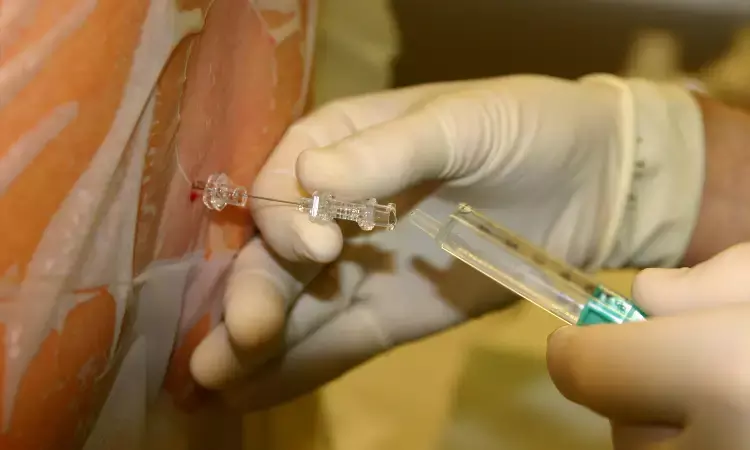- Home
- Medical news & Guidelines
- Anesthesiology
- Cardiology and CTVS
- Critical Care
- Dentistry
- Dermatology
- Diabetes and Endocrinology
- ENT
- Gastroenterology
- Medicine
- Nephrology
- Neurology
- Obstretics-Gynaecology
- Oncology
- Ophthalmology
- Orthopaedics
- Pediatrics-Neonatology
- Psychiatry
- Pulmonology
- Radiology
- Surgery
- Urology
- Laboratory Medicine
- Diet
- Nursing
- Paramedical
- Physiotherapy
- Health news
- Fact Check
- Bone Health Fact Check
- Brain Health Fact Check
- Cancer Related Fact Check
- Child Care Fact Check
- Dental and oral health fact check
- Diabetes and metabolic health fact check
- Diet and Nutrition Fact Check
- Eye and ENT Care Fact Check
- Fitness fact check
- Gut health fact check
- Heart health fact check
- Kidney health fact check
- Medical education fact check
- Men's health fact check
- Respiratory fact check
- Skin and hair care fact check
- Vaccine and Immunization fact check
- Women's health fact check
- AYUSH
- State News
- Andaman and Nicobar Islands
- Andhra Pradesh
- Arunachal Pradesh
- Assam
- Bihar
- Chandigarh
- Chattisgarh
- Dadra and Nagar Haveli
- Daman and Diu
- Delhi
- Goa
- Gujarat
- Haryana
- Himachal Pradesh
- Jammu & Kashmir
- Jharkhand
- Karnataka
- Kerala
- Ladakh
- Lakshadweep
- Madhya Pradesh
- Maharashtra
- Manipur
- Meghalaya
- Mizoram
- Nagaland
- Odisha
- Puducherry
- Punjab
- Rajasthan
- Sikkim
- Tamil Nadu
- Telangana
- Tripura
- Uttar Pradesh
- Uttrakhand
- West Bengal
- Medical Education
- Industry
Naloxone Addition to Opioid Mixture may reduce Pruritis in Spinal Anesthesia for Cesarean Section, finds study

Regional anesthesia techniques, such as spinal anesthesia, are frequently employed for cesarean section (CS) due to their benefits of providing postoperative pain relief and reducing the potential risks of aspiration, awareness, and difficulty in managing the airway. Adding a small amount of naloxone to intrathecal opioids can reduce the high risk of pruritis associated with their use. Recent study evaluated the effect of adding a low dose of naloxone (20 μg) to a fentanyl-bupivacaine mixture on the incidence of pruritus in pregnant women undergoing cesarean section under spinal anesthesia. The study included 80 pregnant patients scheduled for cesarean section under spinal anesthesia. They were randomly divided into two groups: Group F: Received 10 mg of 0.5% hyperbaric bupivacaine (2 ml) plus 25 μg fentanyl Group FN: Received 10 mg of 0.5% hyperbaric bupivacaine (2 ml), 25 μg fentanyl, and 20 μg naloxone.
Study Findings
The study found that compared to the F group, the FN group showed a significant decrease in the incidence of pruritus (33.33% vs 60.53%, p=0.022), prolongation of the onset of pruritus (p=0.006), shortening of the duration of pruritus (p=0.029), and decrease in the severity of pruritus (p=0.039).
Postoperative Comparison
However, the postoperative pain scores, rescue analgesic consumption, and time for first rescue analgesia request were comparable between the two groups (p>0.05). The incidence of maternal side effects and fetal APGAR scores were also similar between the groups.
Conclusion
The authors concluded that the addition of an ultra-low dose of naloxone (20 μg) to the fentanyl-bupivacaine mixture significantly reduced the incidence, duration and severity of pruritus without affecting postoperative analgesia in pregnant women undergoing cesarean section under spinal anesthesia.
Key Points
1. The study evaluated the effect of adding a low dose of naloxone (20 μg) to a fentanyl-bupivacaine mixture on the incidence of pruritus (itching) in pregnant women undergoing cesarean section under spinal anesthesia.
2. The study included 80 pregnant patients who were randomly divided into two groups: - Group F: Received 10 mg of 0.5% hyperbaric bupivacaine plus 25 μg fentanyl - Group FN: Received 10 mg of 0.5% hyperbaric bupivacaine, 25 μg fentanyl, and 20 μg naloxone.
3. The study found that compared to the F group, the FN group showed a significant decrease in the incidence of pruritus (33.33% vs 60.53%, p=0.022), prolongation of the onset of pruritus (p=0.006), shortening of the duration of pruritus (p=0.029), and decrease in the severity of pruritus (p=0.039).
4. The postoperative pain scores, rescue analgesic consumption, and time for first rescue analgesia request were comparable between the two groups (p>0.05).
5. The incidence of maternal side effects and fetal APGAR scores were also similar between the groups.
6. The authors concluded that the addition of an ultra-low dose of naloxone (20 μg) to the fentanyl-bupivacaine mixture significantly reduced the incidence, duration and severity of pruritus without affecting postoperative analgesia in pregnant women undergoing cesarean section under spinal anesthesia.
Reference -
Ahmed SA, Amer AF, Lotfy HA, Mansour RF. The effect of addition of ultra‑low dose of naloxone to fentanyl–bupivacaine mixture on the incidence of pruritis after spinal anesthesia for cesarean delivery: Randomized clinical study. J Anaesthesiol Clin Pharmacol 2024;40:381‑7.
MBBS, MD (Anaesthesiology), FNB (Cardiac Anaesthesiology)
Dr Monish Raut is a practicing Cardiac Anesthesiologist. He completed his MBBS at Government Medical College, Nagpur, and pursued his MD in Anesthesiology at BJ Medical College, Pune. Further specializing in Cardiac Anesthesiology, Dr Raut earned his FNB in Cardiac Anesthesiology from Sir Ganga Ram Hospital, Delhi.
Dr Kamal Kant Kohli-MBBS, DTCD- a chest specialist with more than 30 years of practice and a flair for writing clinical articles, Dr Kamal Kant Kohli joined Medical Dialogues as a Chief Editor of Medical News. Besides writing articles, as an editor, he proofreads and verifies all the medical content published on Medical Dialogues including those coming from journals, studies,medical conferences,guidelines etc. Email: drkohli@medicaldialogues.in. Contact no. 011-43720751


